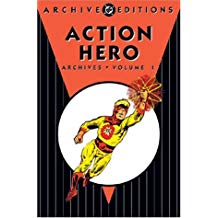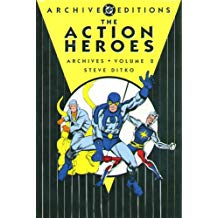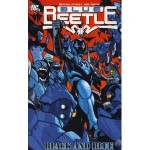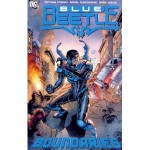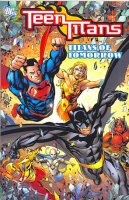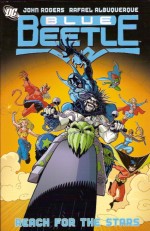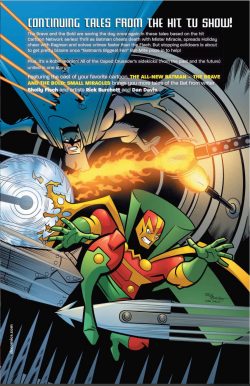
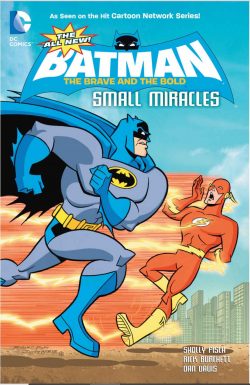
By Sholly Fisch, Rick Burchett, Dan Davis, Robert Pope, Scott McRae, Stewart McKenny & various (DC Comics)
ISBN: 978-1-4012-3852-0 (TPB/Digital edition)
The Brave and the Bold premiered in 1955 as an anthology adventure comic featuring short complete tales about a variety of period heroes: a format reflecting the era’s filmic fascination with flamboyantly fanciful historical dramas. Devised and written by Bob Kanigher, #1 led with Roman epic Golden Gladiator, feudal mystery-man The Silent Knight and Joe Kubert’s Viking Prince. Soon the Gladiator was alternated with Robin Hood, but the adventure theme carried the title until the end of the decade when the burgeoning costumed character revival saw B&B transform into a try-out vehicle like Showcase.
Used to premiere concepts and characters such as Task Force X: The Suicide Squad, Cave Carson, Hawkman and Strange Sports Stories as well as the epochal Justice League of America, the comic soldiered on until issue #50 when it found another innovative new direction which once again caught the public’s imagination.
That issue paired two super heroes – Green Arrow and Martian Manhunter – in a one-off team-up and was followed by more of the same: Aquaman with Hawkman in #51, WWII “Battle Stars†Sgt. Rock, Mme. Marie, Captain Cloud & The Haunted Tank in #52 and The Atom & Flash in #53.
The next instant union – Robin, Aqualad and Kid Flash – evolved into The Teen Titans and after Metal Men/The Atom and Flash/Martian Manhunter appeared, a new hero debuted in #57-58: Metamorpho, the Element Man.
From then it was back to the proven popular power pairings with #59. Although no one realised it at the time, that particular conjunction – Batman with Green Lantern – would be particularly significant….
A return engagement for the Teen Titans, issues spotlighting Earth-Two stalwarts Starman and Black Canary and Earth-One’s Wonder Woman and Supergirl soon gave way to an indication of things to come when Batman returned to duel hero/villain Eclipso in #64: an early acknowledgement of the brewing TV-induced mania mere months away.
Within two issues (following Flash/Doom Patrol and Metamorpho/Metal Men), B&B #67 saw the Caped Crusader take de facto control of the title and a lion’s share of team-ups. With the late exception of #72-73 (Spectre/Flash and Aquaman/Atom), it was thereafter where the Gotham Gangbuster invited the rest of DC’s heroic pantheon to come and play…
Even after the title finally folded, its mighty heritage inspired returns as assorted miniseries and as a second dramatic on-going run in the 2000s.
Meanwhile elsewhere over a few decades, Batman: The Animated Series – masterminded by Bruce Timm & Paul Dini in the 1990s – revolutionised the Dark Knight and subsequently led to some of the absolute best comic book adventures in his 80-year publishing history. It also led to a spin-off print title…
With constant comics tie-ins to a succession of TV animation series, Batman has remained immensely popular and a sublime introducer of kids to the magic of sequential narrative and the printed page. One fun-filled incarnation was Batman: The Brave and the Bold, which gloriously celebrated the team-up in both its all-ages small-screen and comicbook spin-off.
Shamelessly and superbly plundering decades of continuity arcana and the comic book inspirations and legacy of power-pairings in a profusion of alliances between the Dark Knight and DC’s lesser creations, the show was supplemented by a cool kids’ periodical full of fun, verve and swashbuckling dash, cunningly crafted to appeal as much to the parents and grandparents as those fresh-faced little TV-fed tykes…
This stellar collection re-presents issues #15 and 17 of original spinoff series Batman: The Brave and the Bold and #13-16 The All-New Batman: The Brave and the Bold in an immensely entertaining all-ages ensemble suitable for newcomers, fans and aficionados of various vintages. Although absolutely unnecessary to the reader’s enjoyment, a passing familiarity with the TV episodes will enhance the overall experience, but not as much as will knowledge of the bizarre minutiae and lore of DC down the years…
Scripted throughout by Sholly Fisch, and following the TV show format, each tale opens with a brief prequel adventure before telling a longer tale.
We start with a run from the second series. TA-NB:TB&TB #13 was cover-dated January 2012 with Rick Burchett & Dan Davis illustrating ‘…Batman Dies at Dawn!’, as Nightwing leaves his Teen Titan ally Speedy to answer a call from the eerie Phantom Stranger. The enigmatic envoy of the unknown has assembled an army of Robins from the past, present and alternate histories (such as Frank Miller’s Carrie Kelley from The Dark Night Returns) to save a fatally wounded Batman, and their fractious trail leads ultimately to the grandfather of Damien (Robin) Wayne: Ra’s Al Ghul…
Issue #14 (February 2012) sees the Gotham Gangbuster and Blue Beetle wipe out colour coordinated crooks Crazy Quilt, Doctor Spectro and Rainbow Raider before Batman shares a moving and appropriately wonder-packed seasonal fable with Ragman in ‘Small Miracles’. Jewish Rory Regan is very much a minor-league hero working in the poorest part of Gotham, and sees nothing to celebrate until he eventually finds his own miracle after exposing a land-grabbing corporation trying to shut down the local synagogue…
Mister Miracle steals the spotlight in #15’s ‘No Exit’ (illustrated by Stewart McKenny & Davis) as he and Batman are caught in the most inescapable trap of all, but still find their way back to freedom, after which things get really silly and soppy as #16 (April 2012, Burchett & Davis) sees Batman’s battle against the Mad Mod interrupted by 5th dimensional imp and premier stalker/fan Bat-Mite.
Sadly, Batgirl also shows up and for the pesky pixie it’s ‘Love at First Mite’. Cue a whacky wander down the daftest miles of DC’s memory lane and a truly hilarious brief and so-very-doomed romantic encounter…
Wrapping up the comic craziness is a brace of tales from the first series. Batman: The Brave and the Bold #15 (May 2010) saw Fisch, Robert Pope & Scott McRae piling on the weird as Batman joined seminal swinging sixties stalwarts Super-Hip and Brother Power, The Geek in their own eccentric era to stop Mad Mod taking over the Mother of Parliaments (that’s Britain, OK? London, Eng-er-land?) before teaching third Flash Wally West a thing or two about patience and diligence in main feature ‘Minute Mystery’. It all began when someone stole something from the Flash Museum and the superheroes made a contest of finding out what, who, how, and why…
We draw to a close with #17 (July 2010) of that series, with Fisch, Pope & McRae proving ‘A Batman’s Work is Never Done’: tracing one week of standard crimebusting capers with cameo appearances from Metamorpho, Mr. Element, Mongul, the Green Lantern Corps, Toyman, Merry, Girl of Thousand Gimmicks, Jonah Hex, Bat Lash, Hawkman, the Gentleman Ghost, Etrigan the Demon, the Inferior Five, The Creeper, The Scarecrow and Doomsday.
Despite being ostensibly aimed at TV-addicted kids, these mini-sagas are also wonderful, traditional comics romps no self-respecting fun-fan should miss: accessible, well-rendered yarns for the broadest range of excitement-seeking readers. This is a fabulously full-on thrill-fest confirming the seamless link between animated features and comic books. After all, it’s just adventure entertainment in the end; really unmissable entertainment…
© 2010, 2012, 2013 DC Comics. All Rights Reserved.

